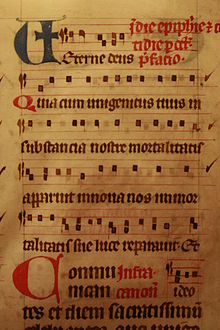
A cappella music is a performance by a singer or a singing group without instrumental accompaniment, or a piece intended to be performed in this fashion. The term a cappella was originally intended to differentiate between Renaissance polyphony and Baroque concertato musical styles. In the 19th century, a renewed interest in Renaissance polyphony, coupled with an ignorance of the fact that vocal parts were often doubled by instrumentalists, led to the term coming to mean unaccompanied vocal music. The term is also used, rarely, as a synonym for alla breve.
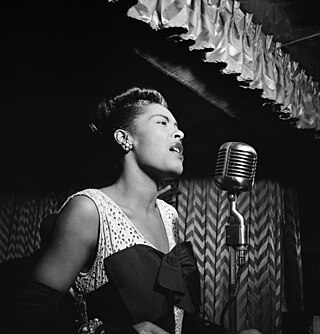
A song is a musical composition performed by the human voice. This is often done at distinct and fixed pitches (melodies) using patterns of sound and silence. Songs contain various forms, such as those including the repetition and variation of sections.
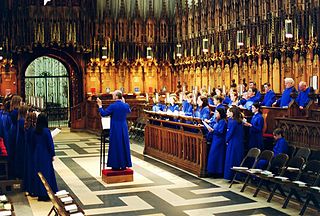
A choir is a musical ensemble of singers. Choral music, in turn, is the music written specifically for such an ensemble to perform. Choirs may perform music from the classical music repertoire, which spans from the medieval era to the present, or popular music repertoire. Most choirs are led by a conductor, who leads the performances with arm, hand, and facial gestures.

An antiphon is a short chant in Christian ritual, sung as a refrain. The texts of antiphons are the Psalms. Their form was favored by St Ambrose and they feature prominently in Ambrosian chant, but they are used widely in Gregorian chant as well. They may be used during Mass, for the Introit, the Offertory or the Communion. They may also be used in the Liturgy of the Hours, typically for Lauds or Vespers.
Articles related to music include:

Gregorian chant is the central tradition of Western plainchant, a form of monophonic, unaccompanied sacred song in Latin of the Roman Catholic Church. Gregorian chant developed mainly in western and central Europe during the 9th and 10th centuries, with later additions and redactions. Although popular legend credits Pope Gregory I with inventing Gregorian chant, scholars believe that it arose from a later Carolingian synthesis of the Old Roman chant and Gallican chant.

Singing is the act of creating musical sounds with the voice. A person whose profession is singing is called a singer, artist or vocalist. Singers perform music that can be sung with or without accompaniment by musical instruments. Singing is often done in an ensemble of musicians, such as a choir. Singers may perform as soloists or accompanied by anything from a single instrument up to a symphony orchestra or big band. Different singing styles include art music such as opera and Chinese opera, Indian music, Greek music, Japanese music, and religious music styles such as gospel, traditional music styles, world music, jazz, blues, ghazal, and popular music styles such as pop, rock, and electronic dance music.

Vespro della Beata Vergine, SV 206, is a musical setting by Claudio Monteverdi of the evening vespers on Marian feasts, scored for soloists, choirs, and orchestra. It is an ambitious work in scope and in its variety of style and scoring, and has a duration of around 90 minutes. Published in Venice as Sanctissimae Virgini Missa senis vocibus ac Vesperae pluribus decantandae, cum nonnullis sacris concentibus, ad Sacella sive Principum Cubicula accommodata, it is sometimes called Monteverdi's Vespers of 1610.

Recitative is a style of delivery in which a singer is allowed to adopt the rhythms and delivery of ordinary speech. Recitative does not repeat lines as formally composed songs do. It resembles sung ordinary speech more than a formal musical composition.
A variety of musical terms are likely to be encountered in printed scores, music reviews, and program notes. Most of the terms are Italian, in accordance with the Italian origins of many European musical conventions. Sometimes, the special musical meanings of these phrases differ from the original or current Italian meanings. Most of the other terms are taken from French and German, indicated by Fr. and Ger., respectively.
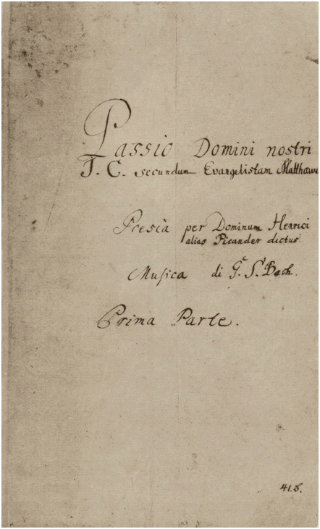
The St Matthew Passion, BWV 244, is a Passion, a sacred oratorio written by Johann Sebastian Bach in 1727 for solo voices, double choir and double orchestra, with libretto by Picander. It sets the 26th and 27th chapters of the Gospel of Matthew to music, with interspersed chorales and arias. It is widely regarded as one of the greatest masterpieces of Baroque sacred music. The original Latin title Passio Domini nostri J.C. secundum Evangelistam Matthæum translates to "The Passion of our Lord J[esus] C[hrist] according to the Evangelist Matthew".
In chant, a reciting tone can refer to either a repeated musical pitch or to the entire melodic formula for which that pitch is a structural note. In Gregorian chant, the first is also called tenor, dominant or tuba, while the second includes psalm tones as well as simpler formulae for other readings and for prayers.
A descant, discant, or discantus is any of several different things in music, depending on the period in question; etymologically, the word means a voice (cantus) above or removed from others. The Harvard Dictionary of Music states:
Anglicized form of L. discantus and a variant of discant. Throughout the Middle Ages the term was used indiscriminately with other terms, such as descant. In the 17th century it took on special connotations in instrumental practice.
Acolouthia in the Eastern Orthodox and Eastern Catholic churches, signifies the arrangement of the Divine Services, perhaps because the parts are closely connected and follow in order. In a more restricted sense, the term "acolouth" refers to the fixed portion of the Office. The portions of the Office that are variable are called the Sequences. While the structure and history of the various forms of the Divine Office in the numerous ancient Christian rites is exceedingly rich, the following article will restrict itself to the practice as it evolved in the Eastern Roman (Byzantine) Empire.
This article describes the principal types of religious Jewish music from the days of the Temple to modern times.

Alexander's Feast is an ode with music by George Frideric Handel set to a libretto by Newburgh Hamilton. Hamilton adapted his libretto from John Dryden's ode Alexander's Feast, or the Power of Music (1697) which had been written to celebrate Saint Cecilia's Day. Jeremiah Clarke set the original ode to music.
An introduzione is a motet for solo voice intended to be sung before certain choral settings of liturgical texts. Eight introduzioni by Antonio Vivaldi survive, each in three or four movements. The texts of introduzioni are non-liturgical but sometimes paraphrase liturgical texts. In the Ryom Verzeichnis, Vivaldi's introduzioni are numbered from RV 635–642.
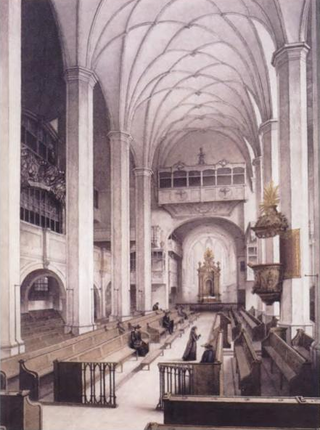
Johann Sebastian Bach composed the church cantata Ein ungefärbt Gemüte, BWV 24 in Leipzig for the fourth Sunday after Trinity and first performed it on 20 June 1723. It is the third new cantata of his first cantata cycle in Leipzig. The title has been translated more freely, for example as "An unstained mind", "An unblemished conscience", "An undisguised intention", and "An unsophisticated mind".
The term "four-part harmony" refers to music written for four voices, or for some other musical medium—four musical instruments or a single keyboard instrument, for example—for which the various musical parts can give a different note for each chord of the music.

Johann Sebastian Bach composed the church cantata Siehe zu, daß deine Gottesfurcht nicht Heuchelei sei, BWV 179 in Leipzig for the eleventh Sunday after Trinity and first performed it on 8 August 1723.
